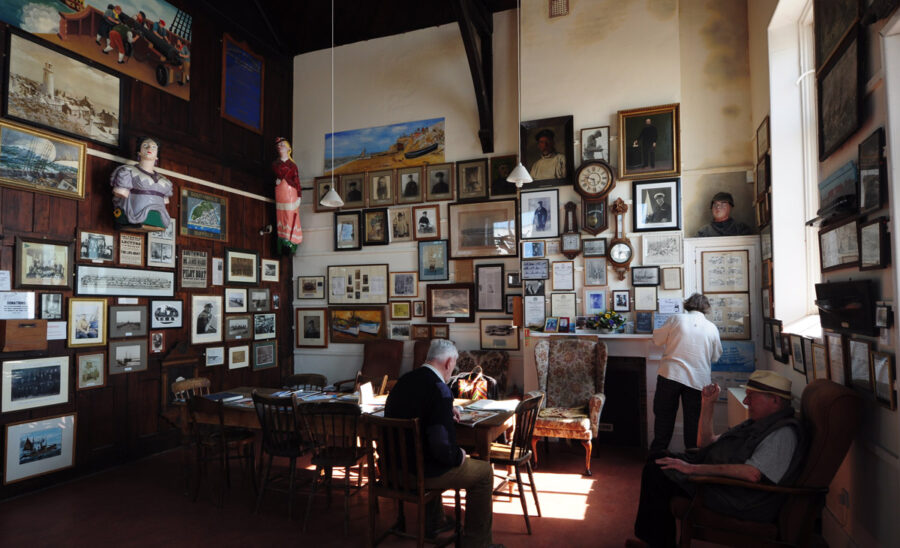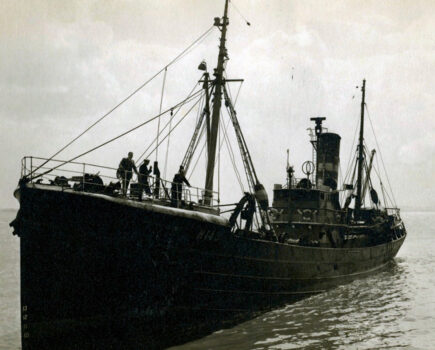A facility set up to improve the minds and morals of Victorian seafarers survives to celebrate east coast maritime heritage. John Worrall reports
It may have been because of the presence of the already noted Sole Bay brewery – which was to become even more noted under Adnams – that a singularly Victorian idea was taken up in Southwold in the 1860s. Keep fishermen and other mariners out of the pub, went the thinking, and improve their minds in the process; give them a place with plenty of reading material, and they would rise from base values to higher things.
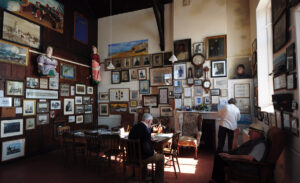
01. Today, the Southwold Sailors’ Reading Room is part library, part museum.
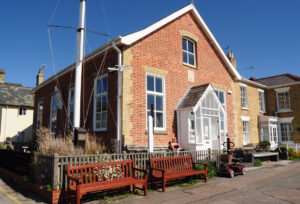
02. The fine Victorian building sits on a clifftop overlooking the sea.

03. Part of the extensive collection of photographs…
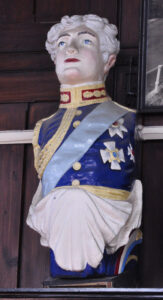
04. … and figureheads, including William IV, otherwise known as Sailor Bill.
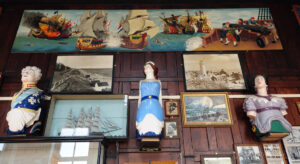
05. One wall is dominated by a mural of the Battle of Sole Bay.
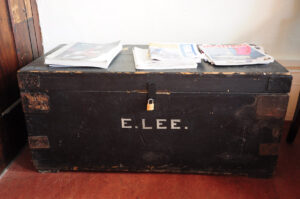
06. The cabin trunk of Captain Lee, which accompanied him to Australia.
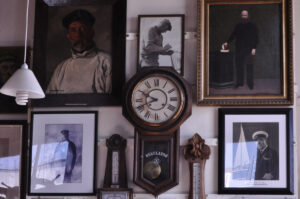
07. Photos and paintings commemorate local fishermen and mariners.
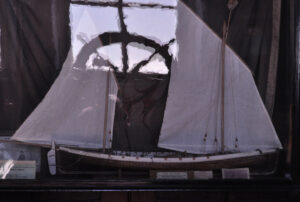
08. A model of the Bittern, one of the salvage vessels that worked from Southwold beach.
Well, they might have done, although evidence of success at the Southwold Reading Room remains anecdotal. But the building is still very much there and, more importantly, in use – except, of course, for a temporary Covid interregnum.
It certainly has a prime pitch. In a town of fine Georgian buildings, this piece of Victoriana sits on the clifftop overlooking the beach at the end of East Street, the natural progression of High Street. It is a spot much frequented today by residents and visitors alike. The fact that any sailors perambulating seawards would, a few yards short of the Reading Room, have first encountered the Lord Nelson, one of Southwold’s fine pubs, may or may not have affected attendance.
The Reading Room was the idea of Frances, second wife of one Captain Charles Rayley RN, who wanted a memorial to her husband after his death in 1863. It was completed the following year by local builder Benjamin Howard Carter, at a cost of £546 4s.
Charles Rayley had buckled a swash or two in a naval career that ranged from the West Indies to the East Indies. He joined as a boy in 1793, serving in the English Channel on the 74-gun Resolution and then the 74-gun Audacious, which was part of Lord Howe’s fleet in an Atlantic action during the French Revolutionary Wars, in which she had a close-quarters slugging match with the 110-gun Revolutionnaire, and came off best – just about, and with lots of bits missing.
Later, in the West Indies, Rayley was wounded in the leg at Santo Domingo and then, in an attack on two privateers, received a sabre cut to the face so severe that the Patriotic Society awarded him £80. He later served on the coast of Africa, and later still was fighting pirates in Borneo, having worked his way up to a command, albeit only with the rank of first lieutenant. But while fighting against the Rajah of Sambas on the Sambas river, his ship, the Barracouta, took heavy casualties from the long guns of the sultan’s forts. Superseded in command after that action, he was shipped home in 1813 and retired with the rank of commander, never to go to sea again.
He moved to Southwold, marrying first a widow, who died, and then Frances Metcalf, the third daughter of the Reverend William Stephens, a dissenting minister in Rochdale. After Rayley’s death, she was moved to commemorate her husband by doing her bit for the health and welfare of local seafarers.
When Frances died in the 1890s, she left the Reading Room to her nephew, a Dr Blackett, who closed it because he didn’t approve of the committee, a bunch of non-conformists, who were nevertheless presided over by the vicar.
But that was eventually sorted out, and when Blackett died in 1922, the Reading Room was sold to a man called Alcock, a merchant navy officer who was at sea at the time. The deal was done by whizzy telegraph. On his death, after the Second World War, it was bought by a local butcher, who wanted it to continue its diversionary work.
Reading rooms were quite the thing in Victorian times and into the early 20th century, though they stemmed from class attitudes, set up by the gentry and clergy to bring improvement to the hoi polloi. But they did find a diversionary niche, imparting learning with newspapers and magazines – less so with books – before libraries, cinemas and radio took up the cause. There were nearly 200 of them in Suffolk alone at one stage, with an overseeing Association of Village Clubs and Reading Rooms.
There aren’t many working examples like the Southwold Sailors’ Reading Room these days, and its survival is substantially down to a donor, who wished to remain anonymous and who, in the 1970s, bought it on behalf of the membership. The Sailors’ Reading Room Association then became a registered charity. Today, it is also part museum – the only one in East Suffolk, they will tell you – which opens every day except Christmas Day and Boxing Day – at least in non-Covid times.
Its exhibits are a mix of photographs, figureheads, ship models, name boards and other artifacts with a nautical connection, though sadly not all with full provenance attached, for the Reading Room remains essentially an informal place, somewhere that anyone can drop in – free of charge – to read the papers and magazines. Running costs are covered entirely by donations and subscriptions, and those who choose to become members for a modest annual subscription get to use the full-size snooker table, which has been in the back room since 1901.
There is something pleasingly small-scale and intimate about the place. Most of the stories attached to the things on display are historical footnotes rather than accounts of major events – even if the Battle of Sole Bay of 1672, between the English and Dutch fleets, which happened out front and is depicted in a large mural, was a biggish deal at the time.
But even the mural is somehow typical of the flavour, painted by local resident John Reeve, and commissioned by someone who happened to live in Captain Rayley’s old house and wanted it for the kitchen. Then he didn’t like it, and for a while it adorned the dining room wall in the Red Lion pub, later passing to Adnams brewery, from where it was acquired by the Reading Room.
A smaller painting depicts the four-masted steamship Pembroke Castle, with Southwold in the background, entitled ‘Right Hon WE Gladstone passing by Southwold, Sept 15th, 1883’. It seems that Gladstone, then prime minister, went on a jolly to the Hebrides at the invitation of the ship’s owner, Sir Donal Currie, and then, untroubled by a modern-day press pack, decided to pop over to Norway to take in a few fjords which, according to Gladstone’s diary, was what they were actually doing on 15 September. But they would have passed Southwold within a few days, because they docked at Gravesend on 20 September.
Other exhibits include a large black trunk formerly belonging to Captain Lee of the P&O liner Strathmore, which carried King George VI and Queen Elizabeth (later the Queen Mother) to Australia. There is also a photographic portrait of the Queen Mother in a display cabinet, which formerly hung in the captain’s cabin. A chalk slate on the north wall mantelpiece gives the tide times each day.
There is the sextant belonging to Captain Simpson, a Southwold man who worked for the Ropner shipping company. He sank a U-boat in the Atlantic with the single deck gun on the freighter Warmsby. Later in the war, he was lost in the Western Approaches. The flagpole outside was presented in his memory.
Also outside is the rudder of Bittern, a beach yawl of a type once much-used by the beach companies in their bounty-hunting salvage endeavours (Fishing News, 7 May, ‘East Anglian Beach Companies: Sharks and saviours’). None of them now survive, but there is a scale model of Bittern inside.
There is also a model of HMS Solebay, a battle-class destroyer decommissioned in 1962. It was made by John Winter, president of the Reading Room Association. He scaled it down from inches to centimetres from another model of Solebay which he borrowed from the town hall – he was also deputy mayor at the time. The destroyer’s nameplate hangs on the wall, having, like the mural, spent time in Adnams brewery.
Of the four ships’ figureheads, one comes from the William IV – named after the monarch known as the sailor king or Sailor Bill – which was wrecked off Walberswick in the 1850s. The rest are impressive but unidentified.
As for the future, it might be supposed that commercial pressures would threaten the Reading Room’s existence. After all, Southwold is a town in the upper league of seaside gentility, with property prices to match – even for mere beach huts. A clifftop site facing the sunrise would attract many conversion-minded admirers.
But the Reading Room has probably embedded itself and its history too deeply into the town’s psyche now for it to be lost to posterity – though with one proviso, which is that its dependence entirely on subscriptions and donations means a constant search for new members and volunteers to ensure continuity. Anyone interested can get in touch via the website: southwoldsailorsreadingroom.co.uk
And talking of posterity, there is a booklet compiled by long-term committee member Douglas Pope, the son-in-law of the late Ted Wass, Fleet Street journalist and first chairman of the Sailors’ Reading Room Association. And, back in Golden Jubilee year in 2002, a time capsule was put into the front wall, containing a CD with a Jubilee programme, a photo of Charles Rayley and a summary of the building’s history. It should all make diversionary reading for some future generation – assuming that there is a museum for CD players.

